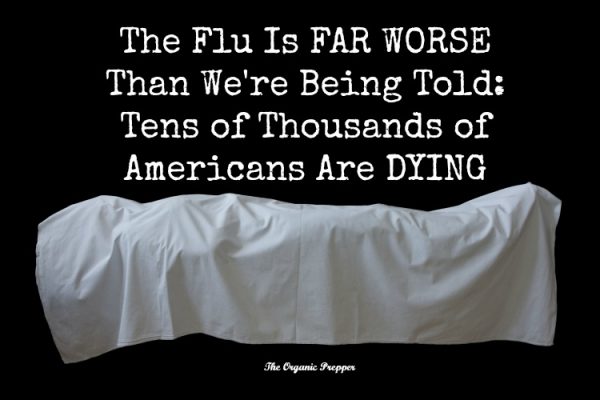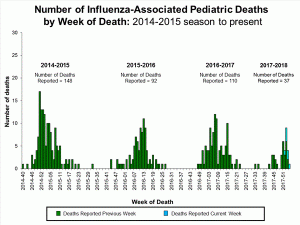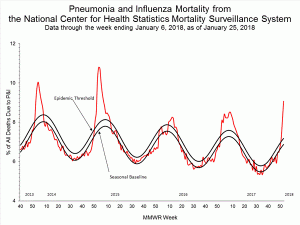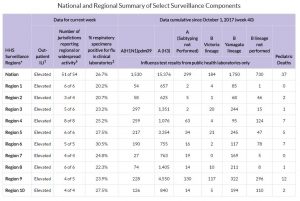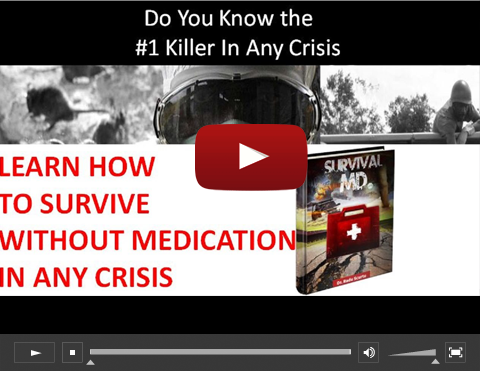We all know that this year’s flu season is bad. I have been pouring over numbers and reports over the past few days, and it’s actually even worse than we’re hearing about. Tens of thousands of Americans are dying. It’s now worse than the 2009 swine flu outbreak and is on track with the 2014-15 strain. And it’s not showing any signs of slowing down.
Despite this, the media is downplaying the severity of the flu and the government makes the statistics pretty difficult to find. Are they trying to avoid a panic? Do they know something we don’t?
Here’s what you need to know about why this year’s flu is so dangerous.
This Year’s Flu Strain Is More Deadly
The dominant Influenza strain this year is H3N2. This particular strain has a history of causing more hospitalizations and more deaths. According to the CDC:
In the past, H3N2-predominant seasons have been associated with more severe illness and higher mortality, especially in older people and young children, relative to H1N1- or B-predominant seasons. Between 1976 and 2007, for example, CDC estimates that an average of 28,909 people died from flu during H3N2 seasons, compared to 10,648 people during non-H3N2 predominant years.
That’s a difference of 18,261 adults each year. And that’s in a good year.
In addition to H3N2 producing a more serious infection in general, this year’s particular H3N2 influenza virus is particularly virulent. The number of deaths due to influenza or complications to the flu, such as pneumonia (a secondary bacterial infection following influenza), varies from year to year.
An August 27, 2010 MMWR report entitled “Thompson MG et al. Updated Estimates of Mortality Associated with Seasonal Influenza through the 2006-2007 Influenza Season. MMWR 2010; 59(33): 1057-1062.,” provided estimates of the range of flu-associated deaths that occurred in the United States during the three decades prior to 2007. CDC estimated that from the 1976-1977 season to the 2006-2007 flu season, flu-associated deaths ranged from a low of about 3,000 to a high of about 49,000 people.
The Current Flu Has Already Killed 44,116 People
In comparison, the current flu has already resulted in 44,116 deaths this flu season. To give that number some meaning, this year’s flu has already led to more deaths than the average for H3N2 years.
Furthermore, we aren’t even in the middle of cold and flu season yet. At 44,116 deaths and counting, we are already nearly to the high end (49,000 people) of the normal flu-associated deaths range.
Fun With Numbers
You would think the CDC would publish an easy-to-find running tally of influenza mortality. They don’t. They only post that information for pediatric mortality. Currently, that number stands at 37.
A total of 37 influenza-associated pediatric deaths have been reported for the 2017-2018 season.
Additional data can be found at: http://gis.cdc.gov/GRASP/Fluview/PedFluDeath.html.
They do, however, provide the information for you to do the math for yourself. On the same page as the above graphic, the CDC provides a chart with the mortality rate presented as a percentage. Here’s that chart.
Below that chart is the option to open up the chart data. This opens an Excel file with the number of people who died from both influenza and pneumonia by week dating back to 2015. I added up the total deaths for the flu and for pneumonia starting in Week 40 (October 2, 2017) and ending in Week 1 (January January 7, 2018). This is what those figures came to:
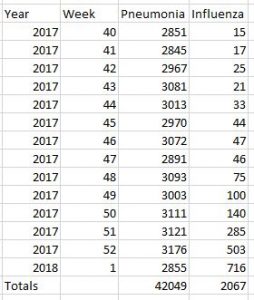
If you add those two totals together, you reach a total of 44,146 people dead.
To make matters even more confusing, the CDC does report lab-confirmed cases of influenza at the top of the same web page. This is the chart.
This chart is somewhat misleading, as it does not compare apples to apples. It presents only cases of lab-confirmed influenza, but not Influenza-Like Illnesses (ILI). ILI cases are just labeled “Elevated”. Thanks, but I could tell that already by just reading my Facebook news feed.
The chart also does not include pneumonia cases. This leaves thousands of cases off the chart.
To add yet another twist, the pediatric mortality total is posted on this same chart. This compares apples to oranges and gives the impression that there are much fewer people sick and dying than there actually are.
Numbers don’t lie. But, they can mislead. If you do add the lab-confirmed cases of influenza together, you get 19,869 cases. That’s a far cry from the 44,146 deaths recorded so far.
The Flu Vaccine Is Historically Less Effective on H3N2
Not only does this influenza strain produce a more intense and deadly flu, the flu vaccine is less effective against it. This Centers for Infectious Disease Research and Policy (CIDRAP) article discusses a study published in The Lancet spanning 11 years that demonstrates H3N2 is more resistant to the flu vaccine.
The study, in The Lancet Infectious Diseases, covered more than 11 flu seasons, from Jan 1, 2004, to Mar 31, 2015. The H3N2 strain has been associated with more severe influenza seasons independent of vaccine effect, according to senior author Edward Belongia, MD, of the Marshfield Clinic Research Foundation (MCRF) in Wisconsin. Among the explanations he and his coauthors offered for the lower strain-specific protection were manufacturing-related factors.
Also from the above CIDRAP article, the flu vaccine demonstrates only a 33% vaccine effective (VE) rate with the average H3N2 strain. This is down significantly from the VE rates against other strains.
The research team determined that pooled VE for the 56 studies was 33% (95% confidence interval [CI], 26%-39%) for H3N2, 54% (95% CI, 46%-61%) for type B, 61% (95% CI, 57%-65%) for 2009 H1N1, and 67% (29%-85%) for prepandemic H1N1.
This Year’s Vaccine Is Even Less Effective than Prior Years
To make matters worse, this year’s flu vaccine isn’t even close to the average 33% VE rate of prior years. This year’s vaccine is performing at approximately a 10% VE rate. This report from CBS News explains how we know this.
What’s more, this year’s flu shot may not be up to the task. It is the same formulation that was used during Australia’s most recent flu season — which typically sets a pattern for what the U.S. will face — and it was only 10 percent effective there.
Nonetheless, the medical community and media are still pushing the ineffective flu vax with all their might.
Resources and Services Are At Risk
The other day, I did an informal “Flu Check-In” through my social media accounts. It was a great way to touch base with hundreds of people around the country. There were loads of reports of hospitals reaching surge capacity, school closings due to high numbers of influenza cases, and people being told by their employers to stay home and telecommute if possible.
Hospitals are at capacity.
Hospitals and medical facilities are usually extra busy during flu season. However, this year, many hospitals are reaching what is called “surge capacity”. Surge capacity is the ability to handle a sudden and dramatic increase in the number of patients needing immediate care.
This is happening because there are more patients seeking out emergency care, and they are staying in the hospital longer. This is leading to a scarcity of hospital beds and available staff.
There seems to be quite a few hospitals at capacity. This is just a tiny sample of hospitals that are either full or almost full.
- Oklahoma City has several hospitals which are full.
- New Jersey hospitals are seeing “patients in the ICU for days and days with influenza”.
- A hospital in Syracuse had to turn people away from the emergency room.
- This Florida hospital had to set up beds in conference rooms.
- All of Augusta, GA hospitals are full with flu patients.
- The LA Times calls the situation local hospitals are facing a “war zone” as they put up tents for the surge of flu patients.
Whether or not you have the flu, hospitals reaching capacity is a risk to everyone. I wrote about this at length in my book Prepping for a Pandemic. When an epidemic or pandemic disease has led to hospitals turning away patients, it doesn’t matter if you get the disease itself.
You could have a heart attack, need an emergency c-section, or need have a burst appendix removed. No beds means no beds. At best, you might be directed to go to another hospital. At worst, they may not have any beds either and send you to another facility at capacity.
School Closings
There are plenty of school closings as well. This is an important step in saving lives, as the H3N2 strain of influenza hits both the elderly and children harder than adults. This can, however, make it tough on parents that cannot get time off of work. Here are just a few places with schools closing. They span all across the country.
Here’s What to Do Right Now
Peak flu season is still to come. Flu season typically begins in October and can run as late as the following May. February is peak flu season. This month historically sees the most cases of flu or influenza-like illnesses.
- Stay away from enclosed populations with influenza if possible. These can include hospitals, nursing homes, schools, shopping centers, college dormitories, gyms, locker rooms, and anywhere else large numbers of people gather where the air is recirculated.
- If you are visiting someone who is in a care facility, do not bring young children or aging parents. They are more at risk than the rest of the population.
- Wash your hands frequently with soap. Soap provides friction which helps to remove pathogens from your hands.
- Stop touching your face. I know this one is hard, but we don’t need to give the flu any help infecting us.
- Take extra good care of your immune system. You will need to fight the flu! Get plenty of rest. Avoid unhealthy foods. Stay hydrated. Avoid smoking. Here is a great article from Harvard with ideas to support healthy immune function and one from this website about reducing your risk of catching the flu.
- Telecommute to work if possible.
- Disinfect things like doorknobs, handles, phones, and anything that multiple people touch throughout the day.
- The flu has an incubation period of 1-4 days before symptoms show, and is contagious a day before symptoms are obvious. Tidiness, clean linens, and fresh air help prevent the spread of germs before symptoms appear.
- If someone at home gets the flu, have them sleep separately, in a room by themselves. Keep your towels separate and your toothbrushes away from the sick person’s items.
This one is deadly.
This virus has the potential to be the worst we’ve seen in a century. You need to take every precaution to keep your family healthy and if someone does get sick, don’t take any risks. Seek medical attention.
How bad is the flu in your area? Share your stories in the comments section.
by Cat Ellis

